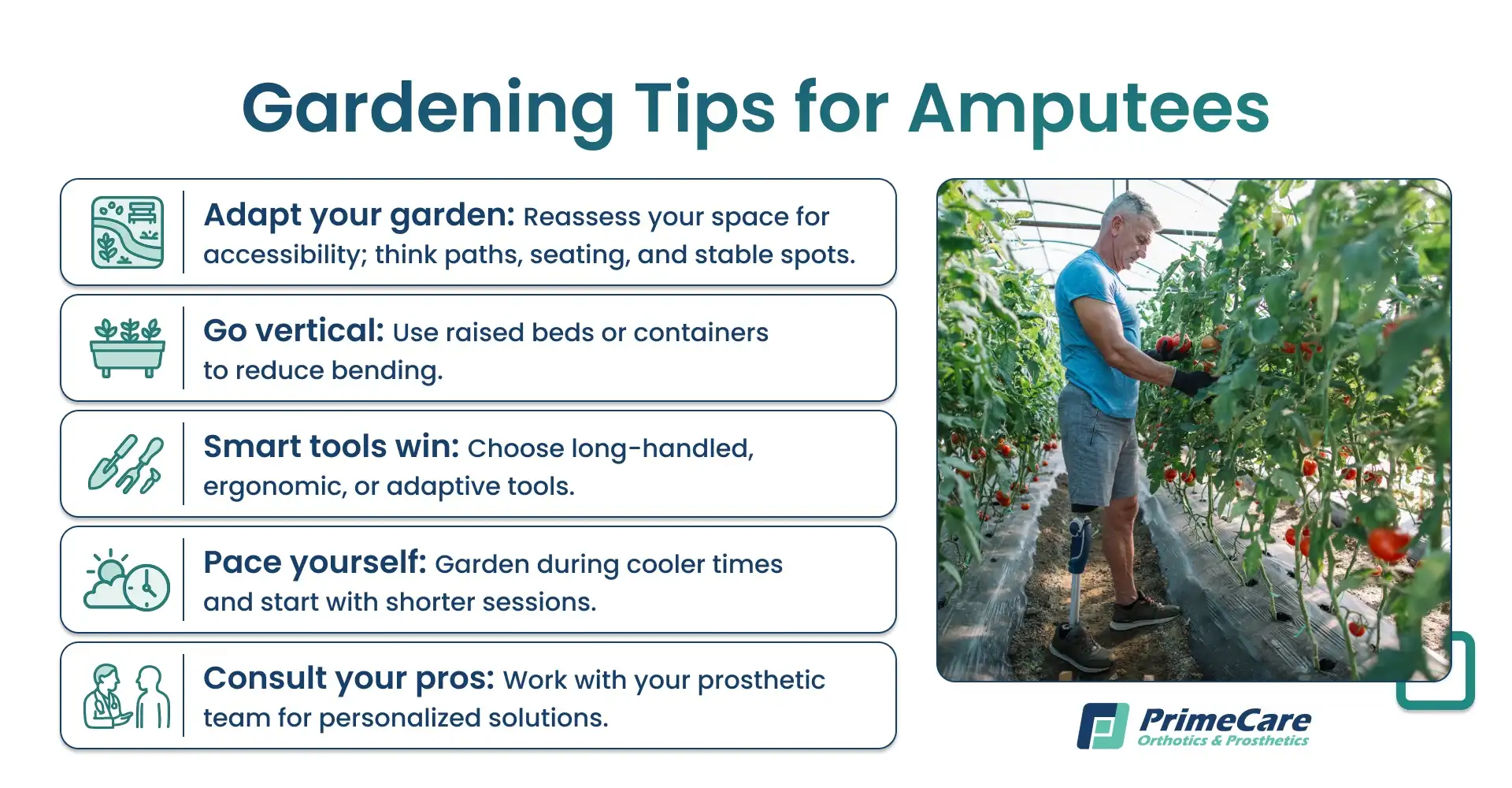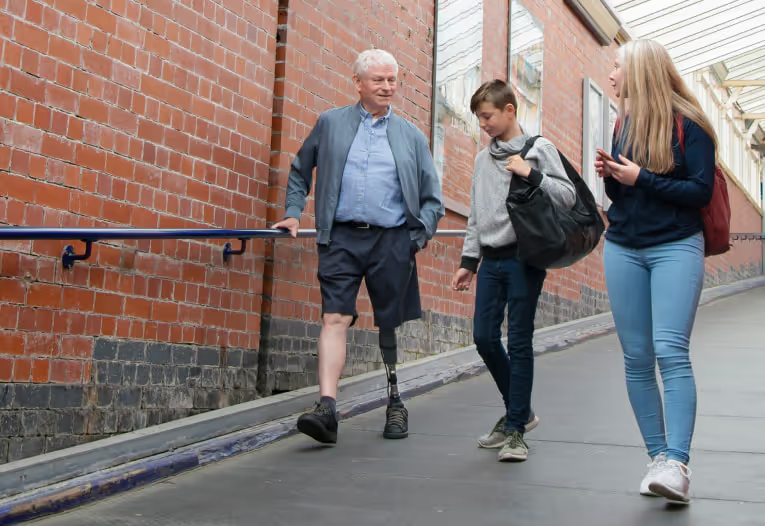Spring mornings in the garden offer a special kind of peace — the smell of fresh soil, the satisfaction of planting new life, and the therapeutic rhythm of tending to growing plants. There’s nothing better! For many lower limb amputees and those with upper limb differences, the question isn't whether they want to return to gardening, but how to make it happen safely and enjoyably.
The good news? With the right approach and some thoughtful adaptations, gardening as an amputee can be just as rewarding as it ever was. Whether this was a hobby you did occasionally or how you spent a majority of your free time, you can return to what you love.
At PrimeCare, we've helped countless New Mexicans rediscover their passion for outdoor activities through custom prosthetic limb solutions designed for real life, not just walking down a hallway, but kneeling in garden beds, pushing wheelbarrows, and creating beautiful outdoor spaces.
The Basics of Returning to Gardening as an Amputee

Gardening isn’t impossible after limb loss. In fact, many amputees successfully maintain elaborate gardens, from simple container arrangements to sprawling vegetable plots. The key lies in recognizing that while some adjustments may be needed, the core joy of nurturing plants and spending time outdoors remains unchanged.
For those who have recently experienced amputation, they know that returning to yard work is often more than just a hobby — it's a milestone in reclaiming independence and normalcy. Physical and occupational therapists encourage gardening as part of rehabilitation because it combines gentle exercise with purposeful activity. Gardening’s varied movements can support recovery while providing the emotional benefits of engaging with nature. There’s nothing quite like spending time gardening.
What makes gardening particularly appealing for prosthetic users is its flexibility. Unlike some activities that demand specific capabilities, gardening is adaptable to match individual abilities and comfort levels. Whether you're focusing on raised beds to minimize bending or choosing tools that work well with your specific device, there's always a way to make it work.
What to Know Before You Get Started
Before you dive back into garden work, take stock of your abilities and limitations. This will make the experience positive and less stressful. Different types of prosthetics offer varying support for gardening activities, and what works for one person may not work for another.
Consider these factors as you plan your return to gardening:
- Balance requirements vary significantly between tasks — pruning while standing differs greatly from weeding at ground level.
- Soil conditions affect stability, especially after rain, when surfaces become slippery.
- Temperature changes can impact how your prosthetic care routine must adapt for outdoor work.
- Duration matters — starting with shorter sessions helps prevent fatigue and potential pain.
- Tool selection is more important when working with prosthetic limbs.
The technology in modern prosthetics has evolved to support active lifestyles, including gardening. Microprocessor-controlled knees adjust to uneven terrain automatically, while specialized prosthetic feet provide enhanced stability on soft soil. Some devices offer enhanced grip patterns for handling tools, while others provide superior stability for uneven terrain. Working with your prosthetic team helps identify which features matter most for your gardening style.
How to Start Your Garden Journey

Your return to gardening requires thoughtful planning, but each step builds confidence and capability. Whether working with an upper-limb prosthesis or adapting to a lower-limb prosthesis, these strategies help create a sustainable gardening practice.
1. Assess Your Space
Take a fresh look at your garden area with mobility in mind. Identify paths that might need widening, areas where you'll need stable surfaces for standing, and spots where you might benefit from seating options. This assessment isn't about limitations — it's about creating a space where you can work comfortably and safely.
2. Choose Appropriate Containers
Raised beds and container gardens are excellent alternatives to traditional ground-level planting. They reduce the need for extensive bending and provide stable edges for support when needed. Many universities have studied adaptive gardening techniques and consistently find that elevated planting areas significantly improve accessibility without sacrificing yield or beauty.
3. Select Smart Tools
Long-handled tools can prevent bending and reaching, while ergonomic grips work better with various hand positions. For those with upper limb prosthetics, including transradial prosthetics or myoelectric hands, tools with loop handles or cuff attachments can provide a good grip without requiring fine motor control. Having the right tools makes an enormous difference in both comfort and productivity.
4. Plan Your Timing
Garden during cooler parts of the day, when you're less likely to experience fatigue. Morning sessions often work best, as the ground is firmer and temperatures are moderate. This timing also helps manage any residual limb sensitivity that heat and perspiration might affect.
5. Build Gradually
Start with small projects and expand as you gain confidence, such as a single container of herbs before tackling larger vegetable beds. This approach allows your body to adapt while you discover what modifications work best for your situation.
Smart Gardening Strategies for Prosthetic Users
Every gardener develops their techniques over time, and those using prosthetic devices often discover creative solutions that benefit any gardener. These strategies work whether using a leg prosthetic, managing with a partial foot prosthetic, or adapting to any other prosthetic configuration.

Work from Stable Positions
Whether sitting on a garden stool or kneeling with proper support, maintaining stable positions prevents unnecessary strain. Some gardeners find that knee pads designed for construction work offer excellent cushioning for prosthetic devices during ground-level tasks.
Embrace Adaptive Equipment
Don’t overlook the importance of equipment. Garden carts that double as seats, kneeling benches with handles for support, and tool organizers that keep everything within reach all contribute to a more enjoyable experience. These aren't concessions to disability — they're smart choices that many gardeners adopt regardless of physical ability.
Manage Moisture and Friction
Gardening can be sweaty work, especially in the sun. This perspiration affects prosthetic fit and comfort. Taking breaks to air out your residual limb and adjust sock thickness helps maintain proper fit throughout your gardening session. Some patients find that having gardening-specific prosthetic socks helps manage moisture better during outdoor activities.
Create Accessible Pathways
Firm, level surfaces between garden areas reduce the risk of trips and falls. Materials like packed gravel, pavers, or even well-maintained grass paths provide stable walking surfaces that accommodate various mobility needs. The importance of good pathways becomes clear after the first rain when dirt paths turn treacherous.
Listen to Your Body

Some days will be better than others for tackling demanding garden tasks, and this is normal and natural. Learn to recognize early signs of fatigue or discomfort to prevent serious injuries and keep gardening enjoyable rather than painful. This awareness develops over time and becomes second nature with experience.
Join Gardening Communities
Why not tap into a garden-focused community? Many areas have adaptive gardening groups where people share tips and experiences. These communities offer practical advice and emotional support from others who've managed similar challenges. Online forums also provide valuable resources for specific questions about gardening with prosthetics. This type of community is also a great place to make new friends.
Growing Forward Together
Gardening with a prosthetic device proves that life after amputation includes all the activities that bring joy and purpose. Whether you're using an ankle disarticulation prosthetic or adapting to a shoulder disarticulation prosthetic, the garden awaits.
At PrimeCare, our New Mexico team specializes in creating prosthetic solutions for real life — helping you return to the daily activities that matter most. We’re proud to offer tailored solutions to our patients to help them live full and healthy lives. Contact us today to discover how we can help you grow beyond limitations!

.svg)
.svg)









